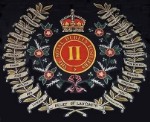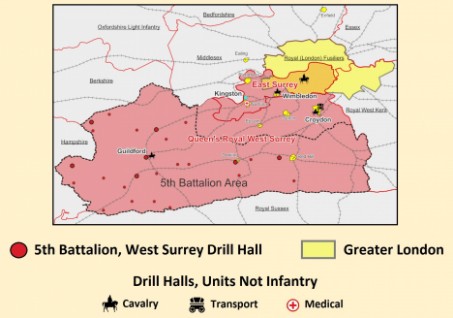Citizen-Soldiers of Guildford and Surrey
Guildford, home to Claud Sykes' family since 1900, like all towns its size, had a number of amateur soldiers, members of the part-time auxiliary forces. Claud's father, while in retirement, spent four years as commander of an army auxiliary unit. At the outbreak of the First World War, about 370 Guildford area residents were enrolled in such units, mainly:
3rd (Special Reserve) Battalion / Queen's Royal West Surrey
Other Special Reserve Units
HQ and Companies C and D, 5th (Territorial) Battalion / Queen's Royal West Surrey
B Squadron / Queen Mary's Surrey Yeomanry
The UK's Amateur Military Forces
The part-time army of the immediate pre-war years consisted of the Territorial Force and the Special Reserve. They were created by the Territorial and Reserve Forces Act, 1907 propounded by Richard Haldane, Secretary of State for War under the Liberal government. The statute effectively combined the Volunteer Force and Imperial Yeomanry into the Territorial Force, ended Militia enrollment, and created the Special Reserve to supplement the Regular Army Reserve. The Territorial Force and Special Reserve, like the Regular Army Reserve, could be mobilized only after Parliament declared a national emergency. About ten thousand amateur soldiers and regular reservists; however, could agree to be called up at any time by the War Office (Army and Special Reserve Section A , Territorial Force Special Service Section). Personnel who did so received annual retainers in addition to their regular TF, SR, and Army Reserve pay.
n/ Territorial and Reserve Forces Act, 7 Edw. 7, c. 9.In the Army Reserve, a maximum of 6,000 men could agree to War Office call-up during their first year after release from full-time service. 61 & 62 Vict., c. 9, §1 as amended by 7 Edw 7, c. 9, §32(2). Such men received annually an extra £9 2s. 6d. in addition to the ordinary reserve pay of the same amount. A similar arrangement existed for a maximum of 4,000 Special Reservists with two-years' SR service. 7 Edw 7, c. 9, §32(1). In the Territorial Force, men who agreed to a War Office call-up not to exceed one month of home service received an extra 10s. per year for "Special Service Section" enrollment. 7 Edw 7, c. 9, §13(2)(b).
In the broadest sense, members of the National Reserve and students enrolled in the Officer Training Corps were also amateur soldiers, though they weren't soldiers at all. The National Reserve was formed by Haldane in 1910 as the "Veteran Reserve." Its officers wore uniforms (enlisted men button-hole badges) at public ceremonies and patriotic events. These veterans, who had no military liability, occasionally assembled ceremonially. For example, in May 1911 and May 1914, retired Field Marshal Lord Roberts, who during the Boer War had commanded the Empire's forces in South Africa, reviewed national reservists at "parades" in Guildford.* The War Office encouraged national reservists to retain small-arms proficiency through membership in shooting clubs affiliated with the National Rifle Association. The Officer Training Corps, created by Haldane in 1908, provided its members, public school and university students, with elementary military training. Like National Reservists, OTC cadets incurred no military obligation but unlike the over-aged men, were issued uniforms.
* Molly Bloom greatly admired the Field Marshal and sang in concert at St. Theresa's Hall while "wearing a brooch for Lord Roberts."
n/ David Rose with the Guildford Institute, Guildford Remembering 1914-18 (Stroud, UK: History Press, 2014); Alan R. Haig-Brown, O.T.C. and The Great War (London: Country Life, 1915); U (Gabler) 18:375-78.
Territorial and special reserve infantry battalions were components of the Regular Army's infantry regiments. Rural Surrey was in the district of the oldest English line regiment of the British Army, having been established by King Charles II in 1661. It was raised by the Earl of Peterborough at Putney (at the time in Surrey), for service in Tangier, Morocco. That regiment was styled Lord Peterborough's Foot. Charles II had received Tangier, a Portuguese possession, as a gift when he married Princess Catherine of Braganza. The British abandoned Tangier in 1684 and the regiment was then renamed The Queen's Royal Regiment in honor of the widowed Catherine.
n/ Website of the National Army Museum at www.nam.ac.uk/explore/queens-royal-regiment-west-surrey. Charles II also received from Portugal the East Indies trading outpost known to the Portuguese as Bom Bahia and its creole inhabitants as Bom Baim. The name was later Anglicized to Bombay.
Gale & Polden Postcard, c. 1910
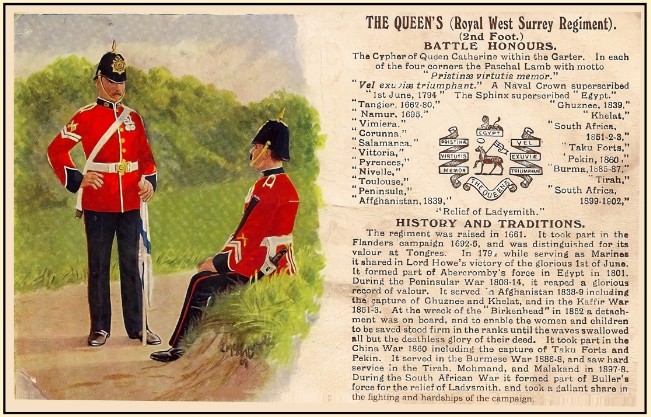
In 1914, the Queen's regimental depot was at Stoughton Barracks, 1.5 miles north of central Guildford. It had been located there since 1876. The depot provided basic training for recruits (regular and militia), hosted HQ for the regimental district, and held weapons, uniforms, and equipment for the area's reservists. At the outbreak of war, the Queen's, like most regiments, had five battalions: two regular, one special reserve, two territorial. One regular battalion was in Borden, Hampshire the other in South Africa.
The Territorial Force
Units of the Territorial Force were administered on a county basis by a Territorial Force Association. Half the TFA members were officers of TF units and the president was the County Lord Lieutenant. TFAs were responsible for recruitment, recommendation to the War Office of officer candidates, and provision of facilities such as drill halls and rifle ranges. TFAs were funded with Parliamentary grants and could accept donations from the public. Open air training facilities for company drill and riflery were often made available gratis by civil organizations (schools, county recreation departments) and private citizens. Regulations for the TF came from the Territorial Force Directorate, Office of the Under-Secretary of State for War. TF units were supervised by the staff of the Army District in which they were located. With some exceptions, each infantry regiment of the British Army had at least one TF battalion. Territorial cavalry formations were styled "yeomanry" and were not linked to regular cavalry regiments. In July 1914, the TF, less yeomanry cavalry, was at 83.9% of authorized strength: 243,359 of 290,101. Infantry battalions were the most under-strength territorial formations.
Territorials were poorly trained and armed. In their first year of service, they underwent only 15-days' full-time training; 8-days or 15-days in subsequent years (about half volunteered for the longer period). TF units were armed with hand-me-downs from the Regular Army so their rifles and artillery guns were of a previous generation. Accordingly, TF combat units had no offensive capability, and only limited defensive capability. In many respects, the TF was similar to the 2nd-line army reserve of France (Armee Territoriale) and Germany (Landwehr).
Enlistments were for 4-years. In a territorial's first year he attended a 15-day training course at the regimental depot and at least 40 "drills" at a nearby drill hall or station. Each drill was one to three hours in duration. In all subsequent years, territorials were required to attend annually 8 days of their unit's summer encampment and 20 drills. To view the pre-war Territorial Force enlistment document in a pdf, click here and it will open from this website in a popup window. For recruiting posters, click here. Note that artillery territorials had to attend 45 drills in their first year.
Like their Volunteer Force predecessors, territorials were not paid for drills but unlike Volunteers, received regular army pay when training full-time. Men who did not perform the minimum number of drills in the year prior to the summer encampment were not paid for that full-time training. To induce territorials to participate in the full, 15-day annual encampment, a £1 bonus was awarded for the extra 7-days' attendance. An unmarried private who attended all 15 days of summer training and was enrolled in the Special Service Section received 45 shillings for the year (at the time equivalent of US $11.25).
Player's Cigarette Cards Publicize the New Territorial Force
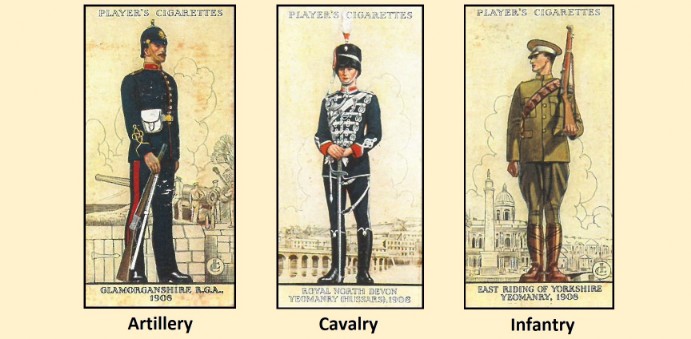
By statute, territorials could not be compelled to serve overseas or be transferred to another territorial unit. Territorials could agree; however, to serve overseas with their own units. Such liability was known as the "Imperial Service Obligation." For a copy of the ISO form, click here and a pdf from this website will open in a popup window.
ISO Badge
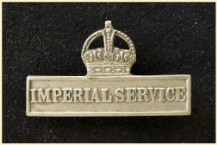
Ten months prior to the outbreak of war, Imperial Service Obligation territorials totaled 1,090 officers and 17,788 other ranks (7.0% of strength). Note that over 90% of the 6th/East Surrey had volunteered for such limited overseas service. It was one of only six formations with that distinction.
n/ War Office, Statistics of the Military Effort of the British Empire in the Great War (London: HMSO, 1922); Territorial and Reserve Forces Act; Territorial Forces Regulations, 1912; War Office, General Annual Report for the British Army, Year Ending September 31, 1913, 1914, [Cd. 7252]; K.W. Mitchinson, The Territorial Force at War, 1914-16 (New York: Palgrave Macmillan, 2014); Ian F.W. Beckett, Britain's Part-Time Soldiers (Barnsley, UK: Pen & Sword, 1991).
Women and the Territorial Force
Women were affiliated with the Territorial Force as nurses. The Territorial Force Nursing Service had 2,783 licensed nurses each with a minimum of three-years' training at one of 34 hospitals approved by the army's Nursing Board. Upon mobilization, they would become uniformed civilians subject to military discipline. Prior to the First World War, the only women who were part of the Regular Army were nurses and schoolmistresses. They were uniformed civilians who served under contract and were subject to military discipline.
TF nurses did not drill, attend summer training camp, or receive pay. Upon mobilization, they received the pay and allowances of the Queen Alexandra's Imperial Nursing Service, which provided nurses for the Regular Army. In the photograph below are seven TF nurses and a Red Cross Voluntary Aid Detachment nursing assistant. These nurse's aides were known as "VADs" and both of Claud Sykes' sisters served as such in Guildford's wartime auxiliary army hospitals. For colorized images of nurses uniforms, click here ; a VAD Home Service attestation form, click here. They are in jpg files on this website and will open in popup windows.
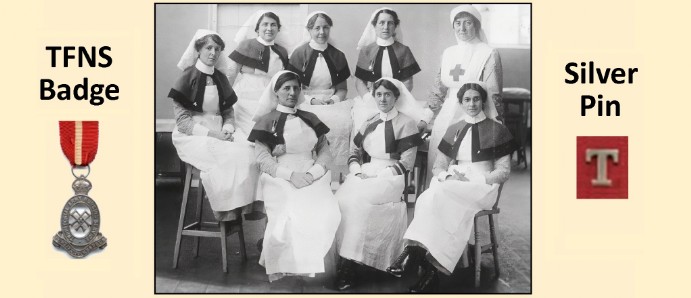
Photograph from The Fairest Force, a website on Great War nurses by Sue Light.
TF nurses were to serve at home and abroad at TF general hospitals. By April 1915, the War Office allowed women to serve in field ambulances and clearing hospitals. For more on the BEF's casualty evacuation system and military nurses, click here and an eight-page pdf from this website will open in a popup window.
Territorial Force medical units administered by the Surrey TFA were 3rd Home Counties Field Ambulance and the Home Counties Division Clearing Hospital, both at Surbiton. Note that as of July 1914, the Home Counties Clearing Hospital was one of eleven such formations not recognized by the Army Council. Only three of the authorized TF clearing hospitals had reached the strength required for recognition: Highland Division at Aberdeen, East Lancashire at Manchester, and Wessex at Exeter. Clearing hospitals had an authorized peacetime strength of three medical officers, a quartermaster, and 42 enlisted men. The Surrey unit had no medical officers and its quartermaster had been commissioned from the Sussex Yeomanry three months before the outbreak of war.
In peacetime, many Red Cross Volunteer Auxiliary Detachments provided nursing assistants for the territorials' summer training camps and large-scale army maneuvers. They would be the only female participants in such activities.
n/ British Red Cross, Nursing During the First World War at www.redcross.org.uk/WW1; Iain Macleod, "The Medals of Elizabeth Clark Neil," The Anatomy Lab, a blog of Surgeons' Hall Museum, Edinburgh; E.C. Freeman, "Clearing Hospitals and the Territorial Force," Journal of the RAMC 15, no. 6 (December 1910): 707-07; Monthly Army List, August 1914; London Evening Standard, May 6, 1914.
The National Reserve
The National Reserve was a pool of men who had completed an engagement with any component of the British Army (Regular, Militia, Volunteer Force, Yeomanry, and Territorial), Royal Navy, or had served as a Regular Army officer for at least one year. Such men could place themselves on the National Reserve register. National reservists did not train, could not be compelled to undertake full-time military service, and enlisted men were not issued uniforms. Officers could wear the uniforms they had purchased previously, but only on ceremonial occasions. The image below shows the Harwich and Dovercourt Company, Essex National Reserve, prior to marching to St. Nicholas Church, Dovercourt. It was that company's first church parade.
Colorized Postcard, 1912
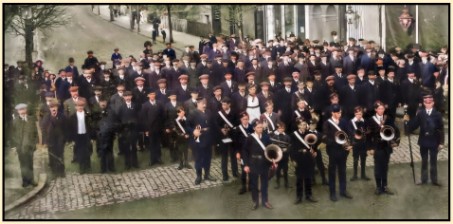
In the above image, the band at the front of the veterans is that of the St. Nicholas Church Lads Brigade.
n/ War Office, Manual of Military Law (London: HMSO, 1914); A Pictorial Postcard History of Harwich, Dovercourt and Parkeston at www.harwichanddovercourt.com/the-army.html.
The National Reserve was divided into three classes, which in 1914 were as follows:
Class | Qualification | Number |
I | Under age 42 and fit for combat. | 14,000 |
II | Officers, warrant officers and sergeants under age 55 and rank-and-file under age 50 fit only for non-combat service. | 46,000 |
III | Same as class II but not physically qualified for any military service. | 140,000 |
National Reservists were not required to undertake any definite liability. They were invited to sign an "honourable obligation" to present themselves for service when required. Names were kept on registers maintained by TFAs. Should a National Reservist accept a call to arms, he would receive the following gratuity: Class I Enlisted Man £10, Class II Enlisted Man £5. For the men of those two classes about one-third had prior service with the Regular Army.
n/ Chris Baker, "The National Reserve," The Long, Long Trail website, www.longlongtrail.co.uk; Manual of Military Law, 1914.
In western Surrey were about 330 national reservists of all classes. They were administered by the county's TFA as the 6th Surrey National Reserve Battalion with companies at Haslemere (50 men), Godalming (80 men), and two at Guildford (200 men). Two days after the UK's war declaration, the 6th NR Battalion's "commander" asked them all to assemble at the Guildford drill hall wearing national reserve badges and all military decorations. On the right is an image of the original Surrey national reserve badge (Veteran Reserve). With the UK at war, a Guildford businessman known for supporting the county territorials, offered to replace at his own expense, the old badges with new ones.
n/ Surrey Advertiser - August 8, 1914, August 10, 1914.
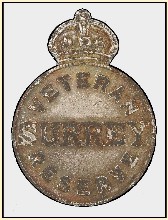
On August 9, 1914 the War Office asked all Class I men and Class II men under age 42 to present themselves for service with the Territorial Force. In October 1914, the War Office opened Territorial Force enlistment to Class II reservists over age 42 and all Class III men. Such recruits were organized into independent Protection Companies to guard vital infrastructure such as railways, docks, power plants, etc. The public viewed these "elderly" soldiers with amusement.
n/ Surrey Advertiser, August 10, 1914; Chris Baker, "The National Reserve," The Long, Long Trail website, www.longlongtrail.co.uk.
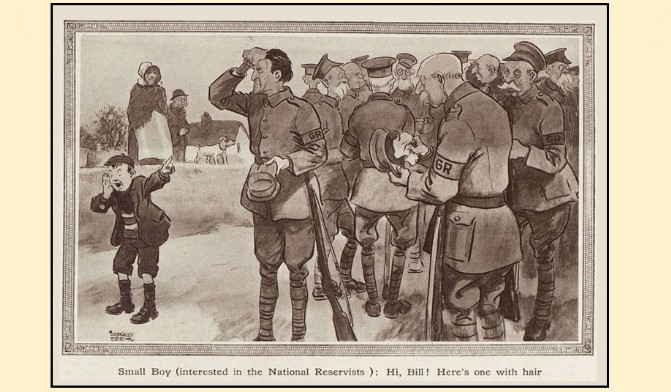
The Tatler, December 1, 1915.
The above cartoon is not too much of an exaggeration. John Reith, a TF officer in the 5th Scottish Rifles, who after the war was the BBC's first general manager, described in his war memoir the scene when he handed over his unit's railway patrol duties to an NR formation. "I paraded the whole of my outfit opposite a body of middle-aged civilians in mufti [civilian clothes] carrying prehistoric rifles and with bayonets projecting from their pockets."
n/ John Reith, Wearing Spurs (London: Hutchinson, 1966), 30.
Though NRs were the subject of public ridicule, their railway protection duty was dangerous work, as noted in the wartime diary of British naturalist Norman F. Ellison who served with 1st/6th (Rifles) Battalion, King's (Liverpool) Regiment:
"It called mainly for night patrols and constant vigilance. A false step meant death and during the seven weeks we performed these duties, eight riflemen were killed by trains."
The War Office soon gave the Protection Companies additional responsibilities such as spotting enemy aircraft and staffing POW camps. In November, the War Office allowed Class II NRs under age 50 to enlist in Home Service TF units.
In January 1915, the War Office began to attach Protection Companies to TF battalions and redesignated them "Territorial Force Supernumerary Companies." By the end of August 1915, the former national reservists of the supernumerary companies totaled 48,699 of which about 10,000 guarded railways.
n/ Chris Baker, "British Army Reserves and Reservists" and "The Royal Defence Corps," The Long, Long Trail; War Office, Statistics of the Military Effort of the British Empire in the Great War (London: HMSO, 1922); David R. Lewis, Ed., Remembrances of Hell: The Great War Diary of Norman F. Ellison (Malborough, UK: Airlife, 1997), 23; Charles Messenger, The Call to Arms (London: Orion, 2005).
The Special Reserve
The Special Reserve was primarily a replacement pool to supplement the Army Reserve. It was created pursuant to the Territorial and Reserve Forces Act as successor to the Militia. Some special reservists, upon mobilization, would serve in distinct units. For the infantry, the replacement pool formations were Special Reserve battalions. The formations that would be deployed as units were the Extra Special Reserve battalions. There were 87 special reserve infantry battalions and 15 extra special reserve infantry battalions. Special reserve battalions of two-battalion regiments were styled 3rd Battalion; four-battalion regiments, the 3rd and 4th. Extra special reserve battalions followed in numbering. Note that for Irish regiments, their special reserve battalions though styled "Reserve" and "Extra Reserve" were replacement pools.
Special reserve enlistments were for six years and reservists participated annually in a month-long training encampment. Enlistees were trained full-time for a minimum of six months. For an SR recruiting poster, click here and the image will open from this website in a popup window. In the infantry, basic training was at the regimental depot; advanced training was with the regiment's regular battalion stationed in the UK. Extra special reserve battalions were authorized 606 reservists plus a permanent staff of 32 regulars, all ranks. Unlike territorials, special reservists were obligated to serve worldwide. As was the case for the Militia, the Special Reserve was plagued with high turnover. About 45% of enlistees left to join the Regular Army while 28% purchased an early discharge, were struck off the rolls for absence, or were invalided out. Only 27% completed their 6-year engagement.
In August 1914, authorized strength of the Special Reserve was 80,120 but only 63,933 were enrolled (79.8%). Infantry authorized strength was 65,877; 49,616 enrolled (75.3%). Accordingly, each SR battalion averaged 486 men. Upon mobilization, 35,000 Regular Army reservists brought the infantry battalions of the British Expeditionary force to war strength; another 15,000 were sent to battalions assigned to four forming divisions. The remaining 30,000 infantry reservists were assigned to the SR replacement pool battalions (about 350 for each).
By the end of 1914, British casualties in France had reduced SR replacement battalion average strength to about 110 trained personnel. As the 87 SR battalions had to provide replacements for 126 Regular Army infantry battalions then in France, the British Army's reserves were effectively exhausted.
n/ War Office, Army Estimates for 1914-15, 1914, HC Accounts & Papers, No. 131; General Annual Report on the British Army for 1912-13, 1914, [Cd. 7252]; Statistics of the Military Effort of the British Empire in the Great War.By the end of 1914, British casualties in France totaled 16,200 dead, 45,700 wounded, and 17,100 missing or prisoner. Throughout the war, the infantry sustained 80% of all casualties. In January 1915, the BEF had in France its initial 6 infantry divisions, 4 new divisions formed with infantry battalions stationed abroad, and 2 Indian Army divisions (each with 3 British infantry battalions).
In June 1915, Claud Sykes' brother Edmund was commissioned into the 3rd/Royal Welsh Fusiliers. After his officer training, he was posted to that battalion's station, Litherland Camp, Liverpool. There, one of his messmates was the famed poet Siegfried Sassoon. In June 1916, Edmund was attached to the regiment's 2nd Battalion which spent the war in France. Sassoon went to the 1st Battalion, also in France, where he formed a friendship with the poet and novelist Robert Graves. During the war, both regular battalions of the Welsh Fusiliers experienced extensive combat.
n/ London Gazette, June 4, 1915; Baker, The Long, Long Trail, Monthly Army List, various; "Royal Welsh Fusiliers," website of the National Army Museum, www.nam.ac.uk.
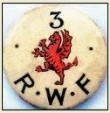
Commemorative Lapel Button
Guildford's Special Reservists
There was no reason for special reservists to live near the regimental depot as it was not the site of the annual training encampment. Charles Daniels, Claud Sykes' publisher 1927-1940, was for several years a special reservist in an Irish Regiment though he lived in England. Usually; however, the local regiment attracted most young men who joined the Special Reserve. Guildford's local regiment was the Queen's Royal West Surrey.
As noted above, in August 1914, there were 63,933 special reservists, 15 for every 10,000 persons in the UK. As the 1911 Census shows the Guildford area with 47,000 inhabitants, likely among them were 70 special reservists.
The "Terriers" of Guildford and Surrey
Surrey, adjacent to Metropolitan London, was somewhat densely populated and accordingly, had more territorial units than most other counties. In 1911, Surrey's population was 713,469 and there were several hundred thousand Londoners who lived within one of the county's two regimental areas. Following are the territorial formations for Surrey in August 1914:
InfantryFifth Battalion, East Surrey, HQ Wimbledon.Sixth Battalion, East Surrey, HQ Kingston upon Thames.Fourth Battalion, Queen's Royal West Surrey, HQ Croydon.Fifth Battalion, Queen's Royal West Surrey, HQ Guildford.CavalryQueen Mary's Surrey Yeomanry, HQ Croydon.ServicesSoutheastern Mounted Brigade Supply and Transport Company at Croydon (Army Service Corps).3rd Home Counties Field Ambulance at Surbiton (Royal Army Medical Corps).Home Counties Clearing Hospital at Surbiton (Royal Army Medical Corps).
The East Surrey Regiment's district included more Londoners than Surrey inhabitants. That district consisted of Metropolitan London's southwestern quadrant and the Surrey registration districts of Richmond and Kingston. Two other infantry regiments had parts of London within their districts: Royal West Kent and Middlesex. The Queen's Royal West Surrey district was entirely within the County of Surrey.
The map below shows the depot location of the two Surrey infantry regiments and headquarters of the four territorial infantry battalions. Also shown are the drill halls for the 5th/Queen's Royal West Surrey and the Surrey territorial cavalry, transport, and medical units. For a large, high resolution view, click on the map and such image will open in a popup window. It will also show company affiliations. Note that the 4th/Queen's (Territorial) area was near the London Metropolis, while the 5th/Queen's (Territorial) area was the rural part of Surrey.
Source: War Office, Territorial Force Return Shewing Unit Headquarters and Outlying Stations (London: HMSO, 1913). TNA WO 114/55.
TF infantry battalions had eight companies each of two platoons while Regular Army battalions had four companies each of four platoons. The War Office had the TF infantry retain the old eight-company structure to facilitate the split of battalions into foreign service and home service formations. The cadres of four companies (commander, second-in-command, company sergeant-major, company clerk, sergeant-instructor, 2 drummers) would form the framework for the war strength companies of the new formations.
Guildford's Drill Hall
Guildford's drill hall on Sandfield Terrace hosted 5th Queen's headquarters and was the principal drill site for the battalion's Companies C and D, each with an authorized strength of 115 (4 officers, 111 other ranks). Nearby Albury and Bramley had drill stations for detachments of Companies C and D, respectively. About 200 Guildford area residents served in these and other components of the 5th Queen's. Rifle ranges for Guildford's territorials were in Bisley and Pirbright, five to seven miles northwest of town.
The "old" Guildford drill hall was a small building on "The Bars" with a 6,200 sq. ft. parade ground at its rear. It was built in the early 1860s to accommodate the 13th (Guildford) Corps of the Surrey Rifle Volunteers formed in 1859. The 13th, like most volunteer rifle corps, was of company strength, about 100 men. In the 1870s, the War Office rationalized volunteer rifle formations and Guildford became home to two companies of the Queen's 2nd Volunteer Battalion. The companies drilled at The Bars on alternating weeknights and Saturday afternoons. In March 1890, the War Office announced the transfer of battalion HQ from Reigate to Guildford effective January 1, 1891. As The Bars facility could not adequately accommodate HQ and two companies, the battalion's officers sought a new drill hall. In the Summer of 1891, the old hall was replaced with a much larger structure across The Bars at its intersection with Sandfield Terrace. The building had originally stood in Edinburgh and officers donated £1,000 to have it disassembled, components shipped to Guildford, then reassembled. A further £1,500 was raised by town residents for a 21-year lease of the Sandfield Terrace site. For more on volunteer units and their drill halls, click here and a pdf from this website will open.
n/ David Rose with the Guildford Institute, Guildford Remembering 1914-18 (Stroud, UK: History Press, 2014); Reading Mercury, November 3, 1860; Ordnance Survey 6-Inch Map, 2nd Ed. (1873); Sussex Agricultural Express, March 29, 1890; West Middlesex Herald, July 27, 1891.
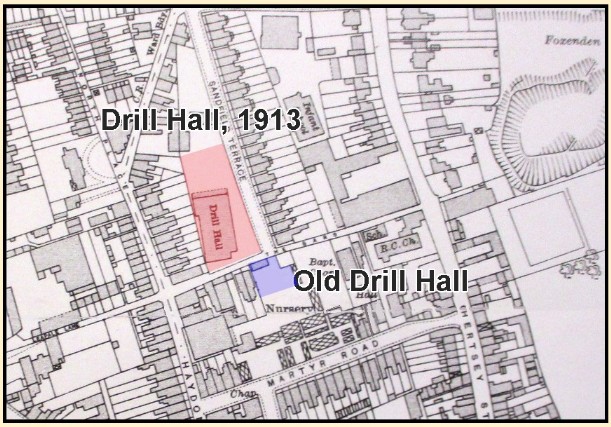
Ordnance Survey 25" Map, 3rd Edition.
As shown in the aerial photograph below, the First World War drill hall is gone but the old drill hall still stands in front of what was its parade ground (still open space). In 2022, the building was occupied by a limousine service. The street photograph was taken in 2015.
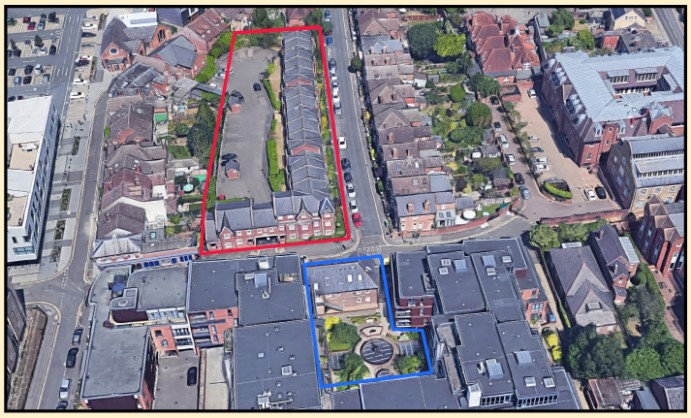
© 2022 Google, Infoterra Ltd, Blue Sky, Maxar Technologies.
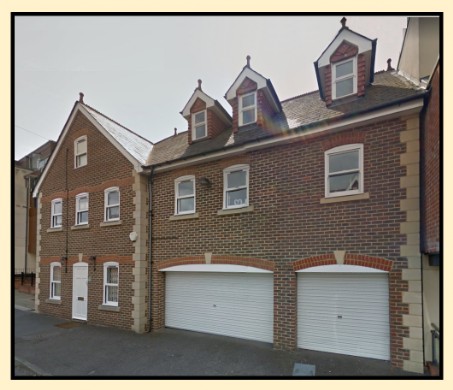
© 2022 Google.
5th Battalion, Queen's Royal West Surrey
On September 20, 1913, the 5th Battalion had 26 of its 29 authorized officers and 798 of its authorized 994 enlisted men. For the battalion's members who lived near Guildford, their weekday evening and Saturday afternoon training was at that town’s drill hall.
The 5th Battalion was mobilized in August 1914 and assigned to the Surrey Brigade of the 44th (Home Counties) Division. All its memebers volunteered for overseas service and civilians flocked to the drill halls to enlist. Of the 824 "trained" territorials, 100 were assigned to the newly formed Home Service battalion, as were 200 new recruits (see, 2/5th Battalion below). By mid-September, the battalion (see, 1/5th Battalion below) was at its authorized war strength of 979 men, all ranks.
n/ War Office, Annual Return of the Territorial Force for 1913, 1914, [Cd. 7254]; Surrey Advertiser - August 1, 1914, September 16, 1914 ; October 28, 1914.
After cursory training first at Maidstone then at Canterbury, the 44th Division sailed from Southampton in November 1914 for India. It was composed entirely of partially trained territorial troops and like the 43rd Division, had been sent to India to replace regular battalions being returned to fight on the Western Front. The 5th Battalion arrived in Bombay on December 1st and was stationed first at Lucknow.
n/ Anthony Neale with David Allen and Nigel Burke, We Will Remember Them, excerpts on the website of the Merrow Residents Association at merrowresidents.org.uk/world-war-2; Surrey Advertiser, December 5, 1914.
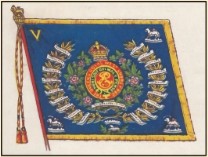
Though a full-strength TF infantry battalion had 979 men on its rolls, it went overseas with somewhat over 800 men, all ranks. That's because army regulations limited soldiers sent abroad to those at least 19 years old who had completed training. One could enlist in the Territorial Force at age 17.
In February 1915, the War office changed the nomenclature for territorial battalions. It gave the original formations "1" as a prefix to the battalion number; the home service formations "2." Accordingly, the 5th Battalion in India was restyled 1/5th Queen's Royal West Surrey.
1/5th Queen's
In mid-1915, the 44th Division was broken up in India and the West Surrey territorial battalion was assigned to the 34th Indian Brigade in the 15th Indian Division. In October, the army assigned that division to the Indian expeditionary force in Mesopotamia which had invaded the Ottoman Empire there in November 1914. When 1/5th Queen’s was ordered to Mesopotamia, its total strength was 821. The 15th Indian Division landed at Basra early in December. The following month, 1/5th Queen's was transferred to the 12th Indian Brigade in the 12th Indian Division. That division had arrived at Basra in April 1915.By November 1915, the 6th Indian Division, the first component of the expeditionary force, had almost reached Baghdad, but was checked by the Turks at the ruins of ancient Ctesiphon, and its commander, MG Charles Townshend, decided to withdraw to Kut-al-Amara. He was besieged there for 143 days and the rest of the British-Indian Expeditionary Force made numerous efforts to relieve the surrounded 6th Division. On April 29, 1916, Townshend surrendered his division's emaciated troops: 2,700 British and 6,000 Indian. After the war ended, the Surrey Advertiser described the terrible treatment of prisoners from the 1/5th Queen's after the capture of Kut. (Click on the link for a transcript in a pdf that will open in a popup window.) They were of a 45-man detachment sent from the battalion in 1915 to reinforce 2nd/Norfolk Regiment, then in Mesopotamia. That battalion was part of General Townsend's division at Kut.
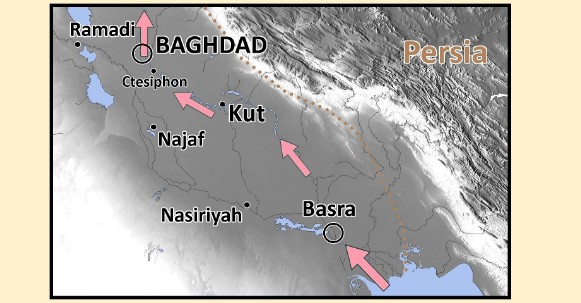
On May 7, 1916 the 12th Brigade, of which 1/5th Queen's was still part, was reassigned to the newly formed 15th Indian Division. Presumably, this was a consequence of the loss of 6th Indian Division a week earlier at Kut. In March 1917, the British-Indian Expeditionary Force took Baghdad and 1/5th Queen's garrisoned the captured city. The battalion next garrisoned Nasiriyah and then Ramadi. At the time of the armistice, it was at Najaf, 50 miles south of Baghdad.
n/ Neale with Allen and Burke, We Will Remember Them; War Diary, 1st/5th Battalion Queen's, TNA WO 95/5193/4-6.
2/5th Queen's
In September, the War Office formed the 5th (Home Service) Battalion/Queen's Royal West Surrey. To attract "gentlemen rankers" to this new formation, its commanding officer limited one of the battalion's four companies to public school men and "sportsmen." In a letter to local newspapers, he noted that this company would be quartered and trained separate from the rest of the battalion. By October 23, the Home Service battalion was near its authorized war strength of 979 men, all ranks. Claud Sykes' brother Philip enlisted as a private in the Home Service Battalion and was probably placed into the gentlemen's company. He was with this unit until March 1915 when he was commissioned in the Denbighshire Hussars.
n/ Surrey Mirror, October 16, 1914; Surrey Advertiser, September 16, 1914; Surrey Mirror, October 23, 1914.
At formation, the Home Service Battalion was headquartered at the Guildford drill hall and its men were quartered throughout town in hired lodgings. The battalion was part of the 2nd Surrey Brigade, 2nd Home Counties Division. Its first posting was to Windsor, half-way between Reading and London.
The battalion never served abroad. In March 1915, only about 375 of its 979 men had volunteered for foreign service and the War Office would only send a territorial battalion abroad if it could field at least 700 men. In May 1915, the War Office split the unit with 400 men sent to the newly formed 2/4th Battalion, and 550 men remaining in the now named 2/5th Battalion. The 2nd Surrey Brigade was renamed the 200th Brigade and its parent formation the 67th Division. Note that 2/4th took part in the failed invasion of Turkey at Gallipoli, then served in Egypt, Palestine, and after the capture of Jerusalem, on the Western Front.
In November 1915, 2/5th Battalion was stationed in Reigate and in July 1916, Westbere, near Canterbury. In 1917, the General Staff saw no need for territorial home defense formations and the War Office disbanded 2/5th in September 1917.
n/ Surrey Advertiser, March 20, 1915; Surrey Mirror - October 16, 1914, October 23, 1914; Neale with Allen and Burke, We Will Remember Them.
3/5th Queen's
The War Office authorized this formation in May 1915 and recruiting began the following month. The 3/5th became the training unit for 1/5th and 2/5th. As such, all new recruits of the 5th Queen's entered 3/5th. Upon completion of training, those eligible for foreign service were sent to 1/5th in India. The others went to the home service 2/5th or were retained with 3/5th.
In April 1916, the War Office restyled these training battalions as "Reserve Battalions" and 3/5th became the 5th Reserve Battalion/Queen's Royal West Surrey Regiment. As such, it was a subordinate unit of the Home Counties Reserve Brigade (Territorial) headquartered at Tunbridge Wells, Kent. In September 1915, the 5th Reserve was merged into the East Surrey's 4th Reserve Battalion. That reserve battalion survived as a training unit until the armistice.
n/ Surrey Advertiser, May 22, 1915; Brad Chappell, The Regimental Warpath 1914-1918, Rev. Ed. (Takoma Park, MD: Tiger Lily/General Data, 2012).
Queen Mary's Surrey Yeomanry
The Territorial Force's 55 cavalry regiments were styled "Yeomanry" and were highly popular throughout Great Britain. At the outbreak of war, these units were at 96.7% of authorized strength (25,141 of 25,993). Officer strength was 89% of establishment as TFAs and regimental commanders imposed high social and financial standards on yeomanry officers. The peacetime strength, including regulars, of a territorial cavalry regiment was 469, all ranks, with a headquarters and four squadrons. Each had six regulars (one officer and five enlisted men). War strength was 589.
Surrey's territorial cavalry was the Queen Mary's Surrey Yeomanry with headquarters at Croydon. On September 30, 1913 it had 20 of its authorized 24 officers and 410 of its authorized 439 enlisted men. The regiment was commanded by Sir John Humphrey, a sheriff of the City of London who was in the stevedoring business and owned several London wharves. The Surrey Yeomanry was a component of the South Eastern Mounted Brigade. Surrey Yeomanry squadrons were located as follows: A at Clapham Park (London), B at Guildford, C at Croydon, and D at Wimbledon.
n/ Statistics of the Military Effort of the British Empire in the Great War; Pall Mall Gazette, August 25, 1914; Ray Westlake, The Territorials 1908-1914 (Barnsley, UK: Pen & Sword, 2011); War Office, Annual Return of the Territorial Force for 1913, 1914, [Cd. 7254].
Until August 1914, B Squadron had no drill hall, merely a "drill station" that consisted of a two-storey, semi-detached house with outbuilding on an adjacent lot. The premises, leased by the War Office from prior to the Boer War, were 58 Denzil Road, just west of the railway tracks. Its resident was the squadron's only regular: A squadron-instructor with the rank of Squadron Sergeant-Major (equivalent to an infantry Colour-Sergeant).
n/ Dorking and Leatherhead Advertiser, December 28, 1901.
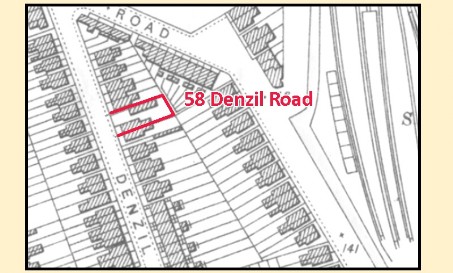
Ordnance Survey, 25" Map, 3rd Ed.
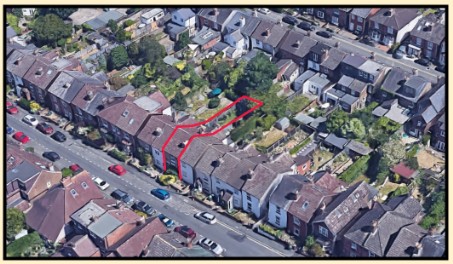
© 2022 Google, Infoterra Ltd, Blue Sky, Maxar Technologies.
Since at least early 1911, Squadron Sergeant-Major Harold Grainger, with his wife and five children, lived at 58 Denzil Road. In 1912, the then 38-year-old soldier purchased the pub at the 18th-Cenutry Nag's Head Inn on Bagshot Road west of Woking. After the war, he operated the pub full-time. The Nag's Head Inn is now a "stylish pub, bar, and restaurant with its very own garden."
n/ West Surrey Times, November 9, 1912; Household Return, Census of England & Wales, 1911; Kelly's Surrey Directory, 1912; website of the Nag's Head Inn at www.thenagsheadinnwoking.co.uk.
In April 1914, the Surrey TFA announced that the Guildford Drill Hall would receive a miniature rifle range and new roof and that a facility for the Surrey Yeomanry would be added. B Squadron would have a two-storey, 75' by 21' building. The work was to be finished in July of that year.
n/ Surrey Advertiser, April 11, 1914.
In 1914, B Squadron was commanded by 35-year-old George Oldroyd Borwick who in 1901 was commissioned into the Surrey Imperial Yeomanry for Boer War service. Borwick was schooled at Harrow and then entered Oxford University from which he received an M.A. In 1906 and again in 1910, he stood unsuccessfully for Parliament as Conservative candidate in solidly Liberal London constituencies (Tower Hamlets, Poplar; Tower Hamlets, Limehouse). In 1915, Borwick married a daughter of the 4th Baron Waterpark and in 1917 received a DSO for his war service. After the war, he served one term as Conservative MP for Croydon North (1918-1922). For a photograph of Borwick, c. 1922, click here and the image will open from this website in a popup window.
n/ Monthly Army List, August 1914; London Gazette, June 11, 1901; Harrow School Register, 1845-1925; Whitaker's Almanack - 1907, 1911; Burke's Peerage, 1921; DeBrett's House of Commons, 1922.
Mobilization, August 1914
At the outbreak of war, the Surrey's were at their summer encampment on Salisbury Plain. On Tuesday, August 4th, while the men were eating in the mess hall, they learned of their mobilization. The Surrey Advertiser reported on Saturday:
"When dinner was served 'before we could get on with it' said our informant 'the officers of B (Guildford) and C (Croydon) Squadrons ran up and said: Up at once, put your dinners in your pockets, and get down to Amesbury Station to entrain.' This was an order to return to their respective headquarters. 'The dinner we had to put in our pockets' the yeoman added facetiously 'was stew! So you can imagine we were able to bring a lot away! The regiment reached Amesbury at 1:15 p.m. on Tuesday and we stood in a field with half-hour reliefs, from a quarter-past one that day until 11 o'clock the next morning in the pouring rain, each man holding horses.' B Squadron (which is under the command of Major G.O. Borwick) reached Guildford on Wednesday afternoon, and in the absence of any definite orders were billeted at various places in the town."
After mobilization, the War Office sent the South Eastern Mounted Brigade to Maidstone, Kent where it was billeted on open spaces made available by their owners. The Surrey Yeomanry lived under canvas while they awaited arrival of horses for war service. It was at Maidstone where the regiment incurred its first casualty. Farrier-Sergeant Henry Belcher was found on August 12th with a stab wound in the throat. As he suffered from depression, there was suspicion the wound was self-inflicted. Belcher died on November 10th, age 38.
From Maidstone, the Surrey Yeomanry went to Canterbury where they were stationed near the British Army's Cavalry Depot. At Canterbury, the regiment shed its home service members who were sent to Dorking.
n/ Westerham Herald, August 15, 1914; Daily Mirror (London), August 13, 1914; Commonwealth War Graves Commission, Netley Cemetery, CofE 1631; UK Death Registrations, 4th Quarter 1914; Baker, "Surrey Yeomanry (Queen Mary's Regiment)," The Long, Long Trail.
1/1st Surrey Yeomanry
The foreign service formation received this designation in early 1915. In December 1914, the army sent A and B Squadrons to France; in March 1915, C Squadron to Egypt. Guildford area yeomanry eligible for foreign service would have been with B Squadron which became a component of the 28th Infantry Division. That division was formed with Regular Army battalions recalled from India and the Colonies. D Squadron was the nucleus of the home service formation, later known as 2/1st Surrey.
2/1st Surrey Yeomanry
From Dorking this unit was sent first to Maresfield, then Wrotham. The South Eastern Mounted Brigade was then styled 16th Mounted Brigade. In July 1916, the War Office merged the 2/1st Surrey with the 2/1st Sussex to form a bicycle unit: 8th Yeomanry (Cyclist) Regiment. In March 1917, the 8th Yeomanry moved to Woodbridge and ended the war in Ireland with its men at Athlone and Galway.
3/1st Surrey Yeomanry
Formed February 1915 at Clapham Park, London as the training unit for the other Surrey mounted regiments. In June, it moved to the Canterbury Cavalry Depot. In early 1917, the 3/1st was sent to Curragh Camp, Ireland and absorbed into the 1st Reserve Cavalry Regiment. That reserve regiment survived as a training unit until the armistice.
n/ Baker, "Surrey Yeomanry (Queen Mary's Regiment)," The Long, Long Trail.
OTC "Old Boys" of Guildford Schools in the Great War
At the beginning of 1914, eight Surrey public schools had junior division Officer Training Corps programs. There were no senior division programs in the county as at the time, there was no university in Surrey. The University of London; however, had an OTC program. There were five OTC corps in the Queen's regimental territory including that of the Royal Grammar School of King Edward VI in Guildford, and the elite Charterhouse School in Godalming, four miles south of Guildford. The King Edward VI School was attended by locals; Charterhouse drew students kingdom-wide and from the colonies. For period postcards of the schools, click on the following links and images from this website will open in popup windows: RGS Guildford, Charterhouse.
Prior to the war, Charterhouse OTC provided the army with 196 commissioned officers; the Royal Grammar School OTC none. From August 1, 1914 through March 15, 1915, 411 former Charterhouse OTC students received commissions; 16 former OTC students of the Royal Grammar School. At the outbreak of war, many former OTC cadets throughout the UK enlisted as rankers. As Charterhouse was a school for the British Establishment, only 79 former cadets joined up as enlisted men (16.1%), just 4 more than from the Royal Grammar School. Among officers who died during the first seven months of the war were twenty-one former Charterhouse cadets (3.6%). Note that the data is of men who had completed the OTC junior course but did not go on to a senior course at university. Among all "Chartusians" who served during the First World War, nearly 700 died and the war memorial on the school grounds is the largest in England.
The Sykes twins, Edmund and Philip, had attended the United Services School, later renamed the Imperial Service College. As the school was founded to prepare sons of officers for military careers, it's not surprising that it had an OTC program. Both boys were cadets and obtained the OTC A Certificate awarded to students who had passed the secondary school OTC course. University students who completed the OTC senior course received B Certificates. For former OTC cadets who later were commissioned in the Special Reserve or Territorial Force, the full-time officer training period was reduced by one month for A Certificate holders, three months for B Certificate holders. Claud Sykes' publisher, Charles Daniels, received an OTC A Certificate at Reading University College. Note that university cadets who had not previously obtained an A Certificate, took the university's junior course as a prerequisite to the senior course.
Prior to the outbreak of war, few OTC cadets went on take reserve commissions. The junior and senior divisions together had provided 755 Special Reserve and 1,445 Territorial officers. In 1913, 688 former cadets took reserve commissions, about 7.5% of students who had completed the program that year.
n/ Monthly Army List, August 1914; Haig-Brown, O.T.C. and The Great War; website of Charterhouse School at www.charterhouse.org.uk; War Office, Army Estimates for 1914-15, 1914, H.C. Accounts & Papers, No. 131.
Links to Other Websites
Note: The webpages will open in new browser windows.
Click on the link to go to that page of the website. Click on the icon to go to the website's home page.
This website is a project of Surrey Heritage, a department of the Surrey County Council. Surrey Heritage manages the county archives and archaeological unit, sponsors events, and maintains an online index to historic documents.
From the Long, Long Trail, a website of Chris Baker with extensive information on the UK and its army during the Great War. It's a reliable source of details about the British Army and its components (regular, auxiliary, and war-service).
Nine-page paper by Graham Webster in a pdf on the website Surrey in the First World War. The website is a repository of his research papers on Surrey in the Great War. Webster (1913-2002) was a noted archaeologist and a leading figure in Roman-British archaeology.
From Sue Light's website The Scarlet Finders, an academic website on British Military Nurses. Most content concerns the First World War. For the TFNS Standing Orders (1912) and Pay and Allowances, click here and it will open from another of Light's websites.
For a comparision of Staff Nurse total remuneration to that of non-combatant soldiers, click here and a pdf on Major Tweedy's Neighborhood will open in a popup window.
Photograph by Andrew Tatham posted on the website of the Imperial War Museum. For the school's history as presented on its website, click on the icon.
On the Merrow Residents Association's website. Firfield, the Sykes family home for over 30 years, was on the Guildford Road one-half mile west of Merrow. Walter Sykes, Claud's father, was active in Merrow's civic affairs and its Anglican church. Note that of the 41 Merrow residents who died in the Great War, 11 had served with the Queen's Royal West Surrey, including 1 of the 5th (Territorial) Battalion.
[ You are at www.majortweedy.com>People>Sykes>Guildford's Citizen-Soldiers ]
